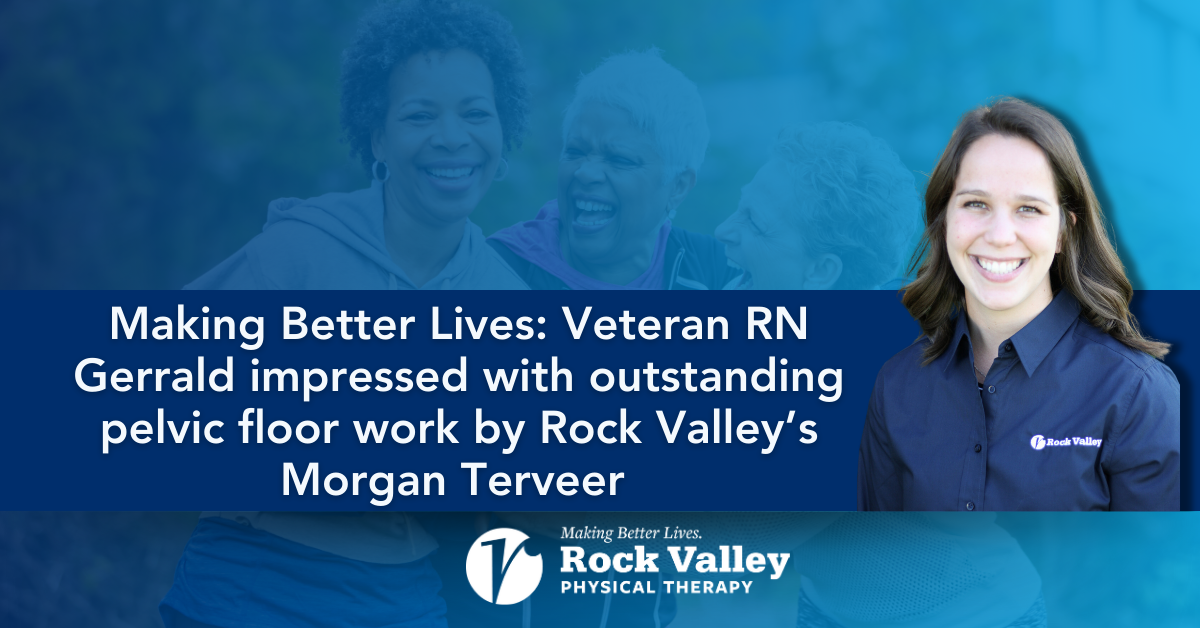There is a unique bond among dedicated and compassionate healthcare professionals.
It involves trust, a willingness to share knowledge, and a tremendous understanding of the situation presented to them.
Princeton, Iowa’s Sue Gerrald, is bright, energetic and has seen most of what one can see medically in a highly decorated, 50-year career as a Registered Nurse.
Her love of UTV riding, her penchant for travel and her overall zest for life, lends proof that Gerrald harbors the day-in-day-out enthusiasm of any 20-something.
Rock Valley Physical Therapy’s Morgan Terveer, PT, DPT, OCS, is gifted and beyond caring in her quest to “Make Better Lives.’’ Her wealth of knowledge in the pelvic floor has earned the trust – and the admiration – of her peers and patients.
And now she has won the approval of Gerrald, a decorated healthcare veteran, who trusted Terveer with her care.
It was no secret there was an issue with Gerrald. She had dealt with a variety of pelvic-floor concerns for an extended period.
The great news is that Terveer – an expert in pelvic-floor matters – understood the problem and had an answer to better the life of someone she has tremendous respect for.
“I requested a referral from my primary healthcare provider for therapy related to stress incontinence, discomfort during sitting with a prolapse sensation and overall feeling like things down there were falling out,’’ Gerrald said of her pelvic-floor struggles. “It made extended time sitting required for our traveling very uncomfortable.’’
Terveer, it must be noted, had an answer.
“We spent a lot of time educating on what your pelvic floor (muscles located between the tailbone (coccyx) and the pubic bone within the pelvis that support the bowel and bladder as well as the uterus and vagina in females) and what role it was playing regarding her symptoms,’’ Terveer said of Gerrald’s pelvic-floor-related issues.
“I think this is really important to help patients understand the what and why behind pelvic-floor therapy, because they’re muscles, we cannot see and it is sometimes hard to feel what you’re doing,’’ added Terveer. “Sue benefitted from both internal and external assessment to learn how to properly engage her pelvic floor for Kegel exercises, especially with proper breathing, and then moved onto more functional strengthening.’’
A five-decade RN with vast experience in various operating rooms, Gerrald has helped with many surgeries related to pelvic organ problems. Surgery for her, however, would be only a last-resort option.
So, she and Terveer tirelessly worked at decreasing pelvic pressure, especially with Gerrald’s love of riding UTVs, and worked to decrease stress incontinence (leakage with cough, laugh, sneeze and lifting).
“Morgan and I agreed on the internal therapy approach due to my understanding of the area,’’ Gerrald said. “She was complete with instructions and always printed out the Home Exercise Program (HEP) that we covered. I do a lot of traveling so our course of treatment extended over a few months. I have met my goals. I have the HEP sheets and exercise bands to continue with a maintenance program. As I have learned from previous physical therapy-area treatments, it is my responsibility to keep the HEP programs a life practice.’’
For as much as Gerrald appreciated, understood, and admired Terveer’s work, it was Terveer who harbored equal admiration for the longtime healthcare professional. She appreciated Gerrald’s understanding of the pelvic floor and her willingness to put in the work to get better both in and outside the Rock Valley walls.
“Sue was awesome to work with as she is a surgical nurse that has worked with urology cases in the past, so she was knowledgeable in this area,’’ said Terveer, who along with Alyssa Hayles, PT, DPT, provide tremendous pelvic floor care for Rock Valley’s Northwest Davenport, Iowa-based location.
“I love to “geek out” on the anatomy aspect of the connection between pelvic floor, diaphragm, and abdominal/gluteal strength, which really made it help make sense to Sue why “just doing Kegels” was not cutting it,’’ added Terveer. “Sue also had a busy travel schedule while I was seeing her, so we were able to organize our therapy schedule to what worked best for her and follow-up over the phone as needed while she traveled. Sue had much better control of her symptoms that had been plaguing her for 2-to-3 years in five visits over a 4 ½ – month period.’’
A unique bond formed by two tremendous healthcare professionals.
By: Johnny Marx, Rock Valley Storyteller
